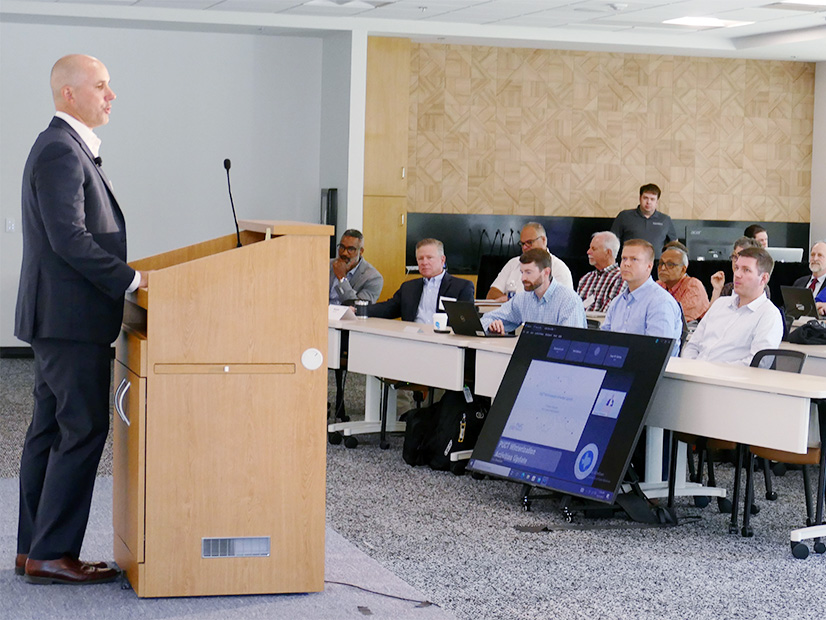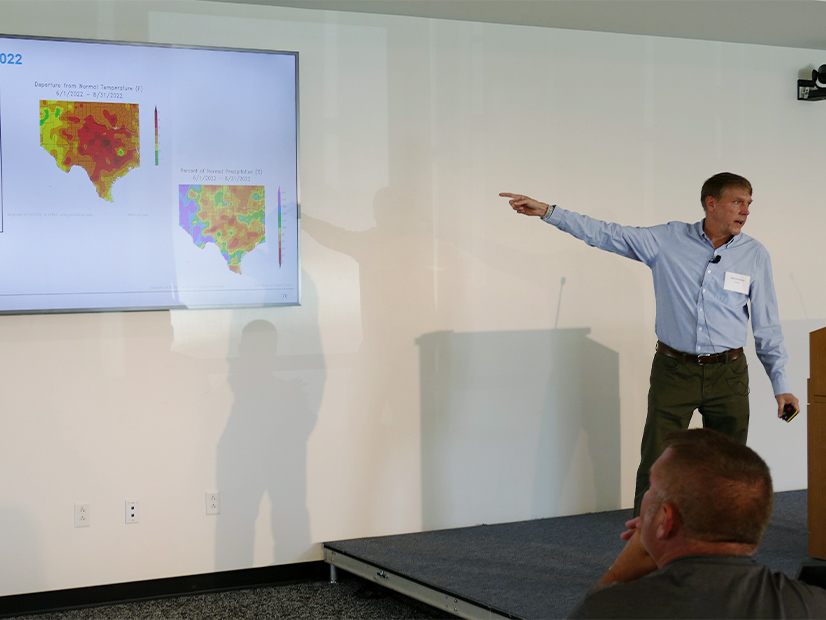
AUSTIN, Texas — ERCOT staff and state regulatory representatives agreed the electricity and gas industries have learned valuable lessons from the February 2021 winter storm, lessons that are now being put into place to winterize and protect critical facilities in the supply chain.
“One of the big lessons we learned coming out of [Winter Storm] Uri was we can’t be stagnant,” Thomas Gleeson, the Public Utility Commission’s executive director, said during the Texas Reliability Entity’s Extreme Events Resiliency Workshop on Sept. 20-21.
Texas RE staff moderated a series of discussions on grid resilience topics with industry experts during the two-day event.
Gleeson chairs the Electric Supply Chain Security and Mapping Committee, which was created by legislation following last year’s storm to prevent mistakenly shutting down critical gas infrastructure during a load shed. The group completed the map’s first version in April, easily beating its Sept. 1 deadline. It identified 65,000 facilities, 60,000 miles of electric transmission lines and 21,000 miles of gas transmission pipeline.
While the mapping committee met in private because it is dealing with critical infrastructure, it did hold two public meetings.
“The goal [of the open meetings] is to rebuild public trust. We need to be out there talking to folks about what we’re doing, why the map has to stay secure and private,” Gleeson said. “It’s important for us to explain the work that we’re doing to ensure to Texans that we are providing them with the best grid that we can.”
Working on a separate path, PUC staff developed expanded weather preparation rules for generators and transmission utilities to ensure reliability during both summer and winter weather events. The PUC adopted those rules on Thursday.
Natalie Dubiel, an attorney for the Texas Railroad Commission, thanked the mapping committee for its work, which started a six-month clock for the regulatory body to adopt its own weatherization rules. The RRC, which oversees the state’s natural gas and oil industries, had its rule in place Sept. 19, beating its deadline by almost six weeks.
“The rule is fairly dense,” Dubiel said. “We did want to get it in place before that timeline just to give our operators a chance to prepare for this upcoming winter, particularly given that this is a whole new area of jurisdiction that the Railroad Commission did not have.”
Rule 3.66, as it’s known, applies to gas supply chain and pipeline facilities. Their operators must implement “weather emergency preparation measures” by Dec. 1 each year that ensure sustained operations during a weather emergency and correct weather-related forced stoppages that prevented sustained operation because of previous weather emergencies.
Dubiel said the RRC broadened the definition of energy emergency to cover more than just load-shed events.
“There may be times the grid is constrained and demand is high. We want gas flowing,” she said.
 David Kezell, ERCOT | © RTO Insider LLC
David Kezell, ERCOT | © RTO Insider LLC
“We’re better prepared than we were last year,” said ERCOT’s David Kezell, who joined the grid operator as its first director of weatherization and inspection last October.
ERCOT developed an inspector training program, hired inspectors and sent them out into the field before last winter to check on generators that failed during the 2021 storm. Kezell said market participants demonstrated “high levels of compliance” last winter. Going forward, inspections will occur before both the winter and summer seasons for generation resources and transmission facilities.
“This really is a team effort. … Where the rubber meets the road is in the facilities and the people that are doing the work,” he said. “We’ve got a new structure in terms of state law. The actual technicians have to do a good job of doing their job, so we applaud them for the effort that they’re going through.”
Cold Weather Standard Nears Approval
Mark Henry, Texas RE’s director of reliability services and registration, said he expects the NERC Board of Trustees to approve the EOP-012-1 (extreme cold weather preparedness and operations) standard during its October meeting, with FERC approval then coming before year-end.
The standard passed NERC’s membership on its second attempt earlier in September. The standard, part of NERC’s Project 2021-07 (extreme cold weather grid operations, preparedness and coordination) in response to the mass outages caused by the February 2021 winter storm, was posted for comment in May. (See “Updates on Standards Projects,” NERC Board of Trustees/MRC Briefs: Aug. 17-18, 2022.)
“There’s a little bit more bite and specificity to [the standard],” Henry said.
The standard revises some requirements instituted after the 2019 cold weather event involving MISO and SPP. It adds freeze-protection criteria to freeze-protection systems; a five-year review of minimum temperatures, cold-weather plans and freeze-protection measures; and corrective action plans for freezing events.
It will take effect April 1, 2023.
Work continues on a second standards authorization request for the 2023/24 winter, Henry said. This phase of Project 2021-07 would set requirements for identifying cold-weather critical components and systems for each generating unit and implementing freeze-protection measures; determining the generating capacity that can be relied upon during “local forecasted cold weather”; and protecting critical natural gas loads from load shed.
Early Projection for Mild Winter
ERCOT’s in-house meteorologist, Chris Coleman, promised his audience they will eventually see a respite from one of Texas’ hottest summers on record. Winter is coming, he said, but it has a greater potential to trend warmer than colder.
The potential of a third-straight La Niña winter is one reason why. Coleman said that since 1950, there have been 26 La Niña winters in Texas. Fourteen of those have fallen in the warmest third of all winters, but three have fallen in the coldest third.
 ERCOT’s Chris Coleman reviews the 2022 summer with workshop attendees. | © RTO Insider LLC
ERCOT’s Chris Coleman reviews the 2022 summer with workshop attendees. | © RTO Insider LLC
“There is some correlation between La Niña and the unlikelihood of a cold winter,” he said. “There’s no correlation between La Niña and a winter with an extreme cold event.”
It can happen, though. Since 1894, Dallas has had 14 winters where the temperatures have reached 5 degrees Fahrenheit or lower. Two of those occurred during La Niña.
“When I say it’s going to be a warm winter, there could still be a day or two, or a week or two, that’s extremely cold,” Coleman said. “You can get some pretty dramatic changes in the winter.”
June through July was the second hottest period for Texas, topped only by 2011. Those months were also the 39th driest on record — 2011 is No. 1 there too — and the fifth driest this century. Austin has recorded 68 100-degree days this year, San Antonio 58, Dallas 47 and Houston 22. One more 100-degree day in Austin would move 2022 into second place for days over the century mark, behind only 2011.
“If you’re getting close to records, you might as well just break the record,” Coleman said. “In fact, I get upset when it’s 99 degrees. ‘Just give me that 100. It’s not like it feels that much different.’”



